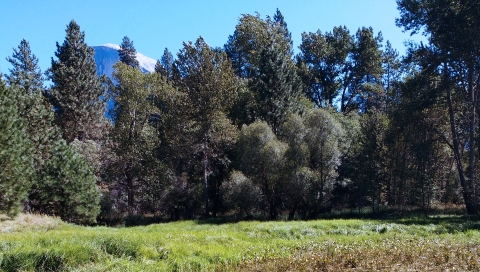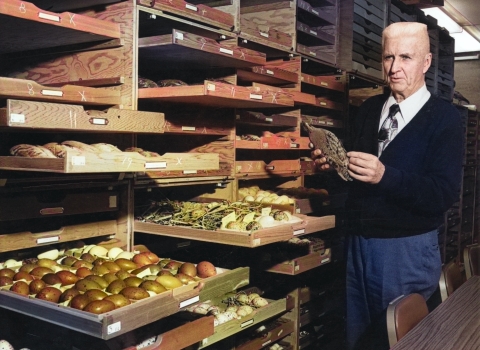When you close your eyes and think of a healthy forest, you may picture one that’s thick with trees. But a healthy forest is complex, just like the plant and animal species that live there.
Rick Kuyper, Sierra-Cascades division supervisor in the U.S. Fish and Wildlife Service’s Sacramento Fish and Wildlife Office, has visited many of California’s forests. Kuyper and his team work alongside federal agencies, including the U.S. Forest Service and National Park Service, to recover listed species living in the Sierra Nevada.
“We work closely with public land management agencies and private landowners to ensure we have healthy forests for the species in the Sierras,” said Kuyper. “Restoring and conserving good forest habitat is a key component to successfully recovering species like the southern Sierra Nevada fisher and Yosemite toad.”
While the forests of California’s Sierra Nevada may not look like the forests near you, there are some things all healthy forests have in common. Here are four features of healthy forests that you can look for on your next journey into the outdoors.
Healthy forests are rich with plant and animal life
The biggest marker of any healthy ecosystem is biodiversity. That means that there is a wide variety of species from all kingdoms of life, whether that be plants, animals, fungi or microorganisms we can’t see.
“We know forests are healthy when we see variety of young and old trees, many different tree species, shrubs, grasses and flowers,” said Kuyper. “When forests are rich in plant life, they also tend to be rich in birds, insects, large carnivores and prey animals.”
A biodiverse forest is a sign that nature’s cycles, such as the food web, nutrient exchange in the soil and the water cycle, are working well. With these cycles in good working order, the forest is more resilient to disease and large, high-severity wildfires.
Healthy forests offer a variety of habitats
Different animals and plants need different forest features to thrive. Forest features change depending on elevation, climate and access to water. If you go exploring, you may find some of the following habitat types in the forest:
- old-growth areas with dense trees and vegetation that provide shade and cover for prey animals like fishers and martens
- open, grassy meadows where grazers can forage and pollinators can find flowers
- downed logs, snags and rocks that provide shelter for animals that seek cavities and burrows, including snakes and rodents
- areas with patchy tree cover so sun and rain can reach short plants, sprouts and the ground
- ponds, creeks, lakes and rivers where aquatic plants and animals such as frogs and beavers live
- green, moist areas around those water sources that include riparian areas and wetlands
“The wildlife in a forest is going to be as diverse as the available habitats. When you walk through a forest and find a meadow and pond surrounded by bushes and trees of different heights and species, there is going to be a bigger variety of animal species there than in a forest that’s just a stand of trees that are all the same species and age,” said Kuyper.
A healthy forest has trees of different sizes and ages
While trees are adapted to the weather and conditions of their native range, climate change is putting more pressure on forests all the time, which is affecting how trees grow. A healthy forest should have a mix of saplings and young trees among the old growth. If there are no young trees, that’s a sign that something in the forest is preventing new trees from sprouting such as poor soil conditions. If mature trees are dying, extended drought or disease could be the cause.
“Mature trees that are already stressed from drought succumb more easily to bark beetle infestations. When bark beetle populations reach high numbers, there aren’t enough predators like woodpeckers and parasitic wasps to keep them in check,” said Kuyper
Next time you’re in the forest, see if you can spot both young and old trees of different trunk sizes.
Healthy forests have clean water
Clean water is needed by all species to survive. A healthy forest has plenty of trees, shrubs and grasses with robust root systems to control erosion. When there aren’t enough plants to hold the soil, rains can funnel too much dirt, ash and other debris into ponds, lakes and creeks, muddying the waters. Erosion is especially bad for aquatic species like frogs whose eggs can get buried by dirt. Water can also be impacted by conditions upstream like the dumping of human waste, garbage or chemicals.
Clean water in the forests is important for everyone, not just the animals and plants that live there. Forests in the mountains play an important part in providing people, fish and other wildlife downstream with clean drinking water.
“Mountain forests are often the starting point for the water we drink in cities. In most cases, the more pure and clean the water is upstream, the better the water that comes out of our tap,” said Kuyper.
Do your part to keep our forests healthy
Wondering now how you can help forests near you? Here are a few tips!
1. When you recreate, follow the Seven Principles of Leave No Trace:
- Plan Ahead and Prepare – Bark beetles travel with firewood, so buy firewood where you plan to burn it. If you’re traveling with livestock, make sure to feed them weed-free hay in the days leading up to the trip so that invasive plants aren’t spread in their droppings.
- Travel and Camp on Durable Surfaces – Going off trail or camping over vegetation can cause erosion or damage fragile species.
- Dispose of Waste Properly – This includes pet waste! Be sure to pack it out as it can bring foreign parasites or bacteria to forest species. All kinds of litter, even food scraps, can cause health problems for animals.
- Leave What You Find – As a whole, it’s best to leave things where you find them, as they might be part of an animal’s home or an important food source.
- Minimize Campfire Impacts – Nine out of ten fires are human-caused. Be sure to check the fire conditions of where you’re going, and avoid making fires on warm, windy days in particular. When there is wind and the vegetation is dry, fires can spread faster than you might imagine and are very hard to get under control.
- Respect Wildlife – approaching wildlife can cause stress to the animals or lethal accidents for the animal or you. Feeding animals encourages animals to associate food with humans, which can cause them to harass humans or lose their ability to get their own food. Animals that become too familiar with people often end up euthanized.
- Be Considerate of Other Visitors – By being considerate of other visitors, you’re showing consideration to all of the species that live there too!
2. Learn more about how climate change is impacting our forests and other ecosystems. Find out what you can do to contribute toward a greener future. This could be things like joining a local volunteer group that plants trees, helping young people in your life grow their love of nature, and so much more.










